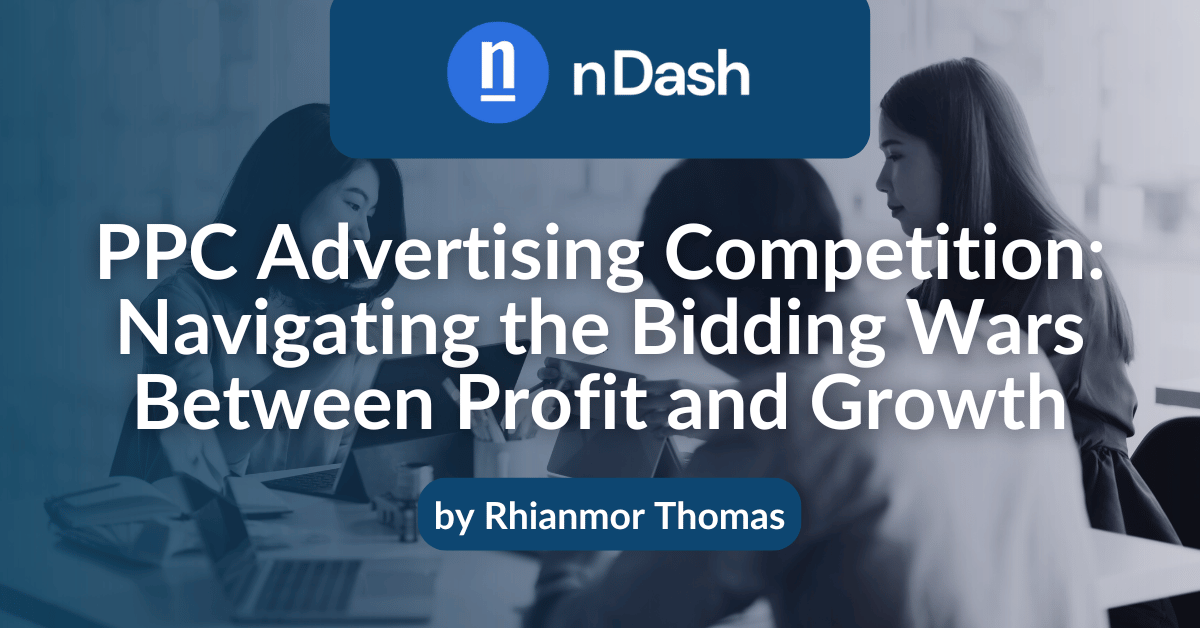Pay-per-click (PPC) advertising ranks among the most popular methods available in digital marketing today. Companies like Google Ads earn billions of dollars annually from brands’ PPC advertising spending. But can advertisers still achieve a positive ROI amid all the competition?
Advertisers see an average return of two dollars for every dollar spent on Google Ads, which would place ROI at 100%. But in today’s fierce PPC environment, profit-driven brands find it nearly impossible to achieve positive ROI in digital marketing.
Let’s explore the dynamics of PPC bidding and their effects on ROI. With current bidding practices becoming unsustainable, there are some actionable strategies brands can use to navigate these challenges.
The State of PPC Advertising
For years, PPC advertising has enabled brands to target audiences and optimize their ad spend precisely. PPC is based on keywords, and advertisers bid on those keywords to get their ads to appear on search engines, websites, and social media platforms. Advertisers must pay a fee whenever someone clicks on one of their ads. With more businesses now competing for keywords, the space has become crowded, and market saturation has driven up cost-per-click (CPC).
Small and medium-sized businesses (SMBs) typically spend between $9,000 and $10,000 monthly on PPC campaigns. Effective budget allocation and continuous optimization are essential to maximize ROI in competitive spaces like Google Ads and LinkedIn Ads. Google Ads helps businesses display ads based on user search intent, reaching people actively searching for products or services. Whereas LinkedIn Ads bidding enables advertisers to target professionals by job title, industry, or company, making it ideal for B2B marketing.
Profit-Driven vs. Growth-Driven Bidding Strategies
In PPC, nearly half of all clicks – 46% – go to the top three paid ads that appear in search. Many brands bid aggressively for these positions. However, high bids drive up CPC, making the right bidding strategy crucial.
Profit-driven brands focus on maintaining positive ROI, carefully managing PPC budgets, emphasizing CPC, maximizing conversions, target cost per action (tCPA), and target return on ad spend (tROAS).
In contrast, growth-driven brands, often backed by venture capital, prioritize long-term growth over immediate profitability. They bid aggressively, aiming to maximize clicks and conversion value, even at the cost of short-term negative ROI. They also strive to maximize conversions and grow their customer base quickly, even if it leads to short-term lower profitability.
This competition creates tension in the PPC market, with growth-driven brands inflating CPC rates and disrupting the profitability of competitors. As a result, profit-driven brands struggle to maintain their ROI, leading to an uneven playing field.
The Bidding Dynamics That Lead to Zero or Negative ROI
Supply and demand heavily influence PPC bidding dynamics and CPC rate determination. Ad space is obviously limited on digital platforms such as Google Ads or LinkedIn Ads. Demand for these placements grows as businesses bid on the same popular keywords or target audience segments, leading to inflated CPC rates.
Profit-driven brands must forcefully increase their bids to stay competitive, but as their bids rise, so does their total advertising cost. Increased conversions may not offset higher ad costs. Keeping up with these high bids will quickly diminish budgets and, consequently, ROI, often pushing it down to zero.
Since profit-driven brands cannot afford to absorb financial losses the way growth-driven brands can, they struggle to remain competitive. This environment is unsustainable for profit-driven brands in the long run.
The Consequences of This Competition
Eventually, profit-driven brands will reach a breaking point where the cost of acquiring customers outweighs the lifetime value those customers bring. To protect profitability, they will be forced to cut back ad spend or exit the market altogether. Continued CPC increases will create a scenario where ad costs outstrip their actual value.
As growth-driven brands continue to inflate CPC, customer acquisition costs (CAC) skyrocket. Shrinking profit margins will make it harder for profit-driven brands to justify continued PPC investments.
Many will reconsider their approach and shift their budgets to other digital marketing channels that offer better value for money. This shift could lead to a deflationary effect in the PPC market, with reduced demand for ad spaces and a subsequent drop in bid prices, like a market bubble bursting. The entire PPC model may be forced to evolve as advertisers seek more cost-effective ways to reach their audiences.
What Can Brands Do?
As brands rethink their PPC strategy, there are several ways that profit-driven brands, especially, can adapt to remain competitive without sacrificing ROI.
Focus On Niche Keywords
If conversion rates are low, top placements are not worth the cost. Top spots often attract users who are just browsing, resulting in fewer conversions and making it difficult to achieve positive ROI. Because niche keywords are highly specific, they usually see fewer searches but attract a more qualified audience. For example, instead of targeting “coffee,” focus on “single-origin organic Ethiopian coffee beans.”
Leverage Organic Growth
Long-term focus is essential for building a brand that can sustain itself beyond paid acquisition strategies. While paid advertising can offer quick wins, it is not a reliable foundation for sustainable growth. Organic growth can be a more cost-effective and sustainable way to grow your business than PPC. By investing in organic growth strategies, a brand can cultivate trust and recognition that continues to drive traffic even in the absence of ongoing ad spend.
Some organic traffic drivers include:
- Content creation: Create high-quality content that is aligned with the needs of your target audience, such as blog posts, video tutorials, or shareable infographics.
- Social media marketing: Post consistently, respond to comments, and utilize trending hashtags to expand reach.
- Email: Build your list organically, offering resources like free guides, newsletters, or exclusive discounts.
- Utilize your leads: Create lead magnets, such as downloadable resources (ebooks, whitepapers, etc.), in exchange for contact information.
- Audience engagement: Host live webinars and Q&A sessions, create polls or surveys, and collaborate with influencers or industry experts.
Increase Conversion Rates With Remarketing
Remarketing campaigns can boost conversion rates by as much as 150%, making them an effective strategy for profit-driven brands facing intense competition in PPC advertising.
Remarketing can also help optimize your PPC budget, increase revenue, and reduce CPA by targeting the most qualified and engaged leads. You can bid more strategically, segmenting the audience based on the level of engagement and adjusting bids accordingly.
Explore Alternative Growth Channels
Diversifying beyond paid advertising is crucial to maximize ROI. Content marketing, influencer collaborations, and social media engagement connect with target audiences and tap into established communities, often at a lower cost.
The Future of PPC Advertising For Profit-Driven Brands
Profit-driven brands face significant challenges in today’s PPC landscape due to the aggressive bidding strategies of growth-driven competitors. The rising CPC caused by these high bids makes it difficult for profit-driven brands to maintain a positive ROI, forcing them to increase ad spend without guaranteed returns.
As a result, many of these brands must reevaluate their PPC strategies, shifting focus to niche keywords, organic growth, and alternative marketing channels to stay competitive. Ultimately, adapting to this dynamic is crucial for long-term profitability in an increasingly saturated market.
About the Author: Rhianmôr Thomas

I am a freelance writer living in Los Angeles. With an undergraduate in Screenwriting and an MBA, I write for a variety of mediums.
Most days, you can find me working on client blogs, articles, website copy, product descriptions, and more. Currently, I write on a range of topics, specializing in B2B & B2C marketing, fashion, film, social media, higher education, and ecommerce.
I always aim to write copy that makes the reader think – about a better way to do something, the future of an industry or just about their opinion on the topic. When you can blend the goals of the client with the ability to make the intended (or unintended!) audience think – that’s successful copywriting.
To learn more about Rhianmôr, check out her writing profile here: Rhianmôr Thomas
